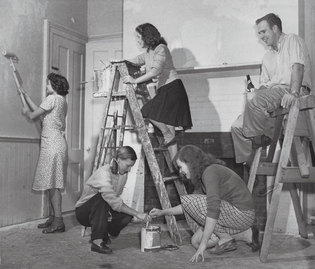 loading
loading
Old YaleYale after World War IIThe Bushes weren’t the only family in extremely close quarters. Judith Ann Schiff is chief research archivist at the Yale University Library.  Manuscripts and ArchivesThis evidently staged photograph, taken at Yale after World War II, is in the archives of Sterling Memorial Library. The caption reads, “Veterans and their wives preparing their apartments for use.” View full imageDuring World War II, Yale was a de facto military training base. In early 1943, an Air Force training center opened on campus; 3,000 cadets took over half the residential halls. More programs followed. By war’s end, 20,000 cadets had been trained at Yale (see “When Yale Schooled for War,” December 2002). As a result, the university had to begin planning for its return to normalcy long before the war ended. “Reconversion” was the term, and it embraced many things. The rare books and manuscripts that had been moved to bomb shelters and the priceless paintings that had been sent away from the East Coast were returned. A program called Yale Studies for Returning Service Men went into operation, with veterans permitted to graduate in six or seven terms. Coping with reconversion was nearly overwhelming. The 900 men who had left in their freshman years were entitled to return, as were the 1,500 who had been admitted but never entered. Younger secondary-school men were entering the college as well, and women the graduate and professional schools. By September 1946 nearly 9,000 had matriculated—dwarfing the prewar student total of 5,000. Occupancy in the residential colleges was doubled; 200 were given rooms in homes of faculty and local alumni; some were assigned to Ray Tompkins House and to an old hospital in West Haven; and about 300 slept on cots in the gym until a used set of Navy barracks was put up on Science Hill. As for the dining halls, the printed menus, linens, and waitress service of the old days—all of which had been put on hold “for the duration”—were gone for good. Then there were the married undergraduates and their families. Some were accommodated in “Quonset huts”—small residences with curved roofs and walls of corrugated metal, like tin cans sliced top to bottom and laid horizontally. A hundred were put up near the Peabody and the Yale Bowl. Other families occupied fraternity houses and Hillhouse Avenue mansions. George H. W. Bush ’48, with his wife Barbara and baby son George W. ’68, lived at 37 Hillhouse, next door to Yale president Charles Seymour ’08. The elder Bush later reminisced: “There were a dozen other veterans’ families sharing the house with us—each with one child, except for Bill and Sally Reeder, who had twins. That made 40 in all.” Berkeley College master Samuel Hemingway ’04, ’08PhD, wrote in his 1945–46 report: “Never has the College seen a more well-behaved, hard-working, serious-minded group of students than our Veterans have proved to be; and their example has had a very salutary effect on the little boys.” As he noted, the oldest veteran was 30, the youngest freshman 16. The 1946 commencement was a four-day celebration bringing back suspended traditions, such as honorary degrees, a Yale-Harvard baseball game, and an alumni parade to Yale Field for the game. (Yale defeated Harvard, 6–3. The lineup included the future ’48 captain, “Poppy” Bush.) On Sunday the university chaplain, Reverend Sidney Lovett ’13, gave a sermon in Woolsey Hall in commemoration of the 495 Yale men known to have lost their lives in the war; the total was later found to be 514. The 1947 Yale Banner summed up the new era with relief and hopefulness: “This year, for the first time since 1940, Yale can look back on a year, if not of normality, at least of recovery; recovery of delayed ambitions, postponed goals, cherished traditions.”
The comment period has expired.
|
|